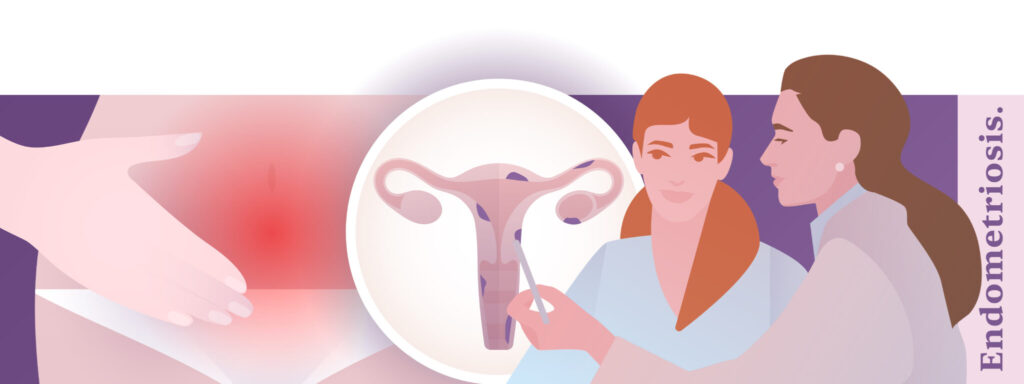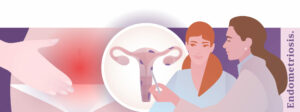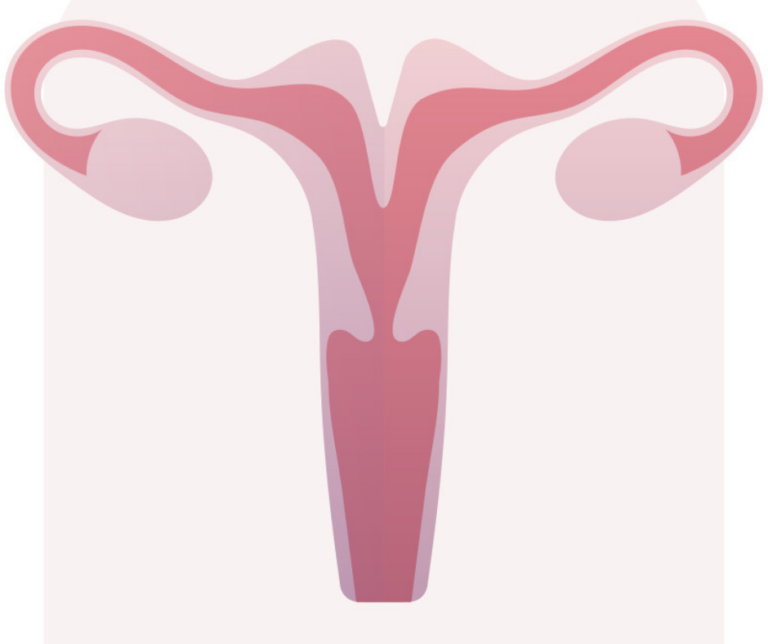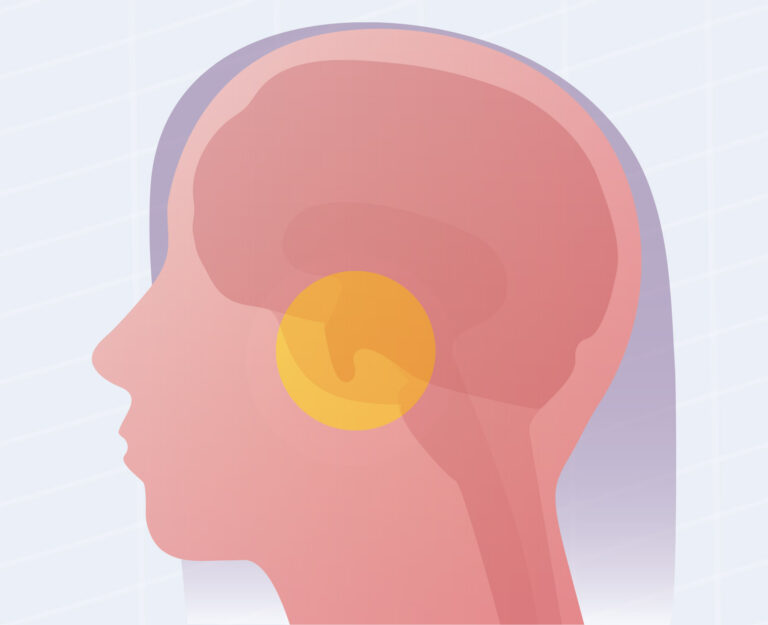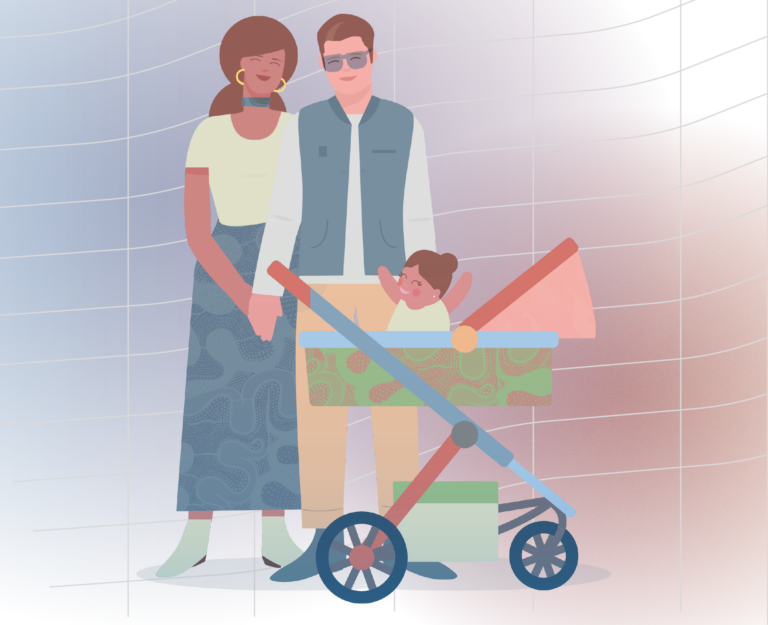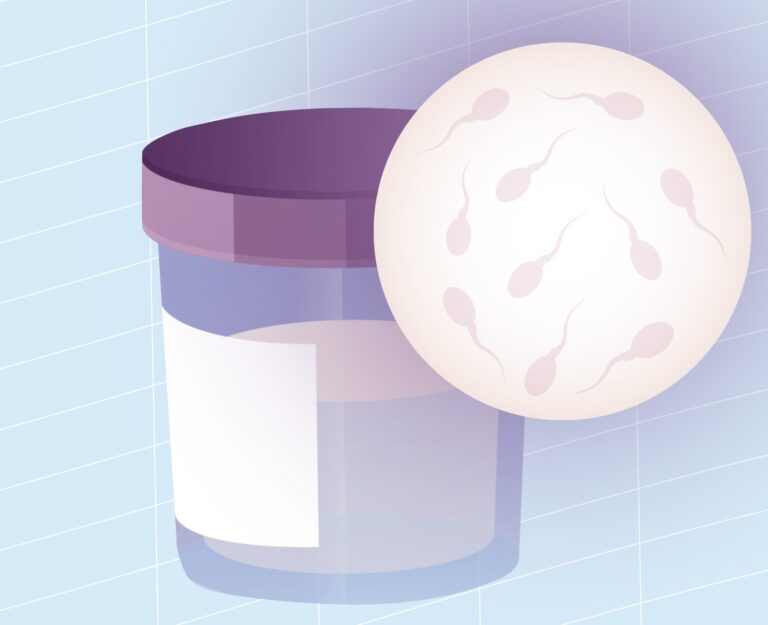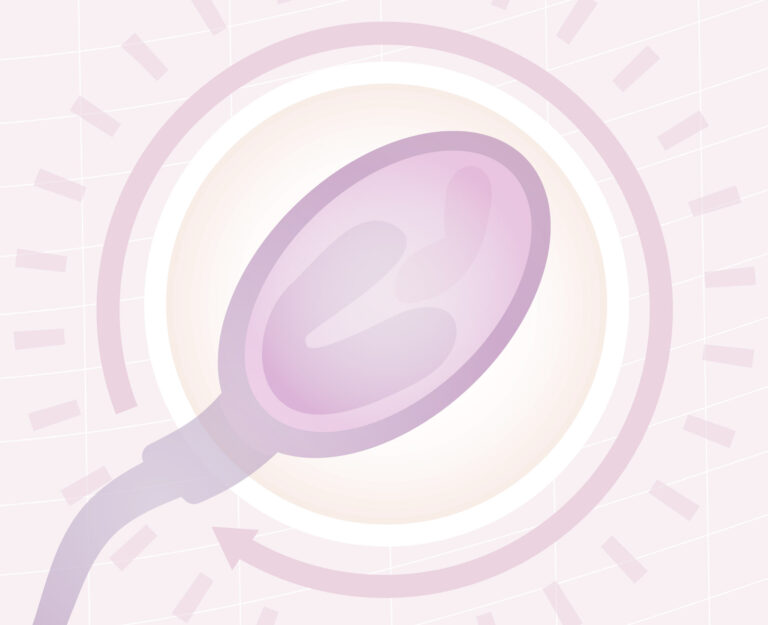Table of Contents
ToggleWhat is endometriosis?
Endometriosis is a disease or disorder related to the female reproductive system, specifically to the mucous tissue layer that lines the uterine cavity, called the endometrium.
Very briefly, this is how the endometrium works: the ovaries produce hormones during each cycle, which make the endometrium thicken, creating a layer that is essential for embryo implantation. In cycles where pregnancy does not occur, the endometrial tissue is usually shed together with blood through menstruation.
We talk about endometriosis when endometrial tissue grows outside the uterus, in other parts of the body, such as the ovaries, fallopian tubes, intestines, bladder, etc.
Are there different types of endometriosis?
Yes, we can distinguish different types or stages of this disease, depending on the area or location where the abnormal cell growth occurs, or on the extent of the disease and the amount of tissue found outside the uterine cavity.
Stages of endometriosis
Endometriosis is a chronic and progressive disease, so extrauterine endometrial cells can invade different areas to a greater or lesser extent. In this way, we can classify it according to the degree of involvement from I to IV.
- Stage I (minimal): Isolated implants with no adhesions.
- Stage II (mild): Superficial implants smaller than 5 cm. Adhered to or spread over the surface of the peritoneum and ovaries.
- Stage III (moderate): Multiple superficial or invasive implants.
Adhesions around the fallopian tubes or peri-ovarian areas, which may be evident. - Stage IV (severe): Multiple superficial and deep implants,
including large ovarian endometriomas (cysts). Extensive membranous adhesions are usually seen.
*Information taken from the Care guide for women with endometriosis in the Spanish National Health System (SNS)
Types of endometriosis
We can also classify endometriosis according to its location:
- Superficial peritoneal endometriosis (type I). This is the most frequent form of the disorder. The tissue tends to implant on the most superficial part of the ovaries and the superficial peritoneum. It appears as reddish lesions and small scars may also form.
- Ovarian endometriosis (type II). In this case, we are dealing with small cysts that contain a brownish fluid (hence their common name “chocolate cysts”) and usually adhere to the ovarian fossa, fallopian tubes and bowel.
- Deep infiltrating endometriosis (type III). This is the most severe form of endometriosis. In this case, the nodules adhere to the deeper layers of the peritoneum and the whole pelvic cavity. And although this type of endometriosis is less frequent, it can cause significant problems for the patient.
What causes endometriosis?
The exact causes of endometriosis are not known, although some studies suggest that endometrial cells may exit the uterus through the fallopian tubes towards the pelvic cavity, a process known as retrograde menstruation. However, we also know that many women with this type of menstruation never develop endometriosis, so other triggering factors must be involved.
Other theories include the spread of endometrial cells through the blood vessels or lymphatic system. Furthermore, studies suggest a link between a woman’s immune system and the development of endometriosis.
In addition, other factors have been associated with the development of the disease, such as a genetic predisposition or the onset of menstruation at an early age (early menarche).
What are the symptoms of endometriosis?
The most common symptoms are:
- Severe pain during menstruation or sexual intercourse.
- Bowel pain or pain in the lower abdomen.
- Pain with bowel movements or when urinating during menstruation.
- Heavy uterine bleeding.
- Very heavy bleeding or spotting between periods.
- Gastrointestinal or digestive discomfort.
- Fatigue.
- Reproductive problems and infertility.
In any case, one of the most recurrent symptoms, which has the greatest impact on the health and quality of life of women with endometriosis, is severe pelvic pain, which affects around 75% of them. It mainly appears during menstruation and can sometimes worsen over time, especially in more advanced forms such as deep infiltrating endometriosis.
In addition, many women, despite having had painful periods or other symptoms, do not discover that they have endometriosis until they try to get pregnant and encounter difficulties conceiving. At that point the disease is diagnosed, which in many cases significantly affects their fertility.
Diagnosing endometriosis
The first step towards diagnosis is to see a doctor if you have any of the symptoms mentioned.
However, these signs and symptoms are not always present. In fact, there are women with advanced endometriosis who hardly feel any pain, and others with small peritoneal (abdominopelvic) adhesions who experience very intense pain. This is the main challenge in detecting the disease. In many cases, the diagnosis is made when a woman has difficulty achieving a natural pregnancy, or even when she undergoes surgery for another reason, such as appendicitis.
Sometimes, during an ultrasound scan performed for other reasons, endometriotic lesions are found by chance.
On top of this, many women normalise period pain: they believe that it is normal for periods to hurt, and therefore do not see a doctor because of it.
All these factors can contribute to a late diagnosis and, as a consequence, endometriosis may already be in an advanced stage. When should you see a specialist?
As a general rule, you should consult an expert as soon as you suspect that you may have this disorder: if you have some of the symptoms we have mentioned, if there is a family history, if your periods are unusual, or if you have been trying to conceive for some time without success.
How do I know if my period pain is normal?
The pain we feel during menstruation is often caused by uterine contractions (similar to those that occur during labour). These mild contractions help the uterus shed the endometrium. During menstruation, substances called prostaglandins are also released, which increase the intensity of the contractions and can therefore make the pain worse.
Dysmenorrhoea, or period pain, affects around 40–60% of women, but there are warning signs that may indicate secondary dysmenorrhoea caused by another gynaecological problem, such as endometriosis, ovarian cysts, pelvic inflammatory disease, polyps or fibroids, intra-abdominal adhesions, cervical canal obstruction, etc.
You should pay attention if:
- You are over 25 years old and severe pain appears for the first time.
- The pain prevents you from carrying out your daily activities and does not improve with treatment.
- The pain suddenly becomes much worse.
- You have a fever together with the pain.
- You experience the same pain even when you are not having your period.
- You have pain during sexual intercourse.
If you notice any of these signs, the best thing is to see your gynaecologist to check whether the pain is caused by something more than “just” menstruation.
Treatment for endometriosis: can it be cured?
Unfortunately, we cannot say that endometriosis can be cured. It cannot be prevented and it cannot be completely eradicated, but there are increasingly effective treatments that can relieve symptoms and significantly improve patients’ quality of life.
The choice of treatment approach will depend on the patient’s needs and how the disease is affecting her: whether she needs to relieve pain, reduce bleeding, or her main wish is to achieve a pregnancy.
There are several treatment options:
Pharmacological treatment with painkillers
Pain, as we have mentioned, is one of the frequent symptoms and one of the most disabling, both physically and psychologically.
Depending on the patient’s needs, the following may be prescribed:
- Painkillers / anti-inflammatory drugs, such as paracetamol, ibuprofen, metamizole, etc.
- Antihyperalgesics, for example amitriptyline, duloxetine, gabapentin, pregabalin, etc.
- Opioids, such as morphine, fentanyl, methadone, etc.
It is essential that any pharmacological treatment is individualised and supervised at all times by a healthcare professional.
Sometimes it can also be complemented with psychological support, physiotherapy or, in more complex cases, referral to specialised pain units.
Hormonal treatments
Hormonal therapy is another option to relieve pain, especially in women with deep infiltrating endometriosis, although it does not prevent the development of the disease. In addition, some women respond better than others to hormonal treatments.
There are different options and routes of administration that may be recommended depending on each case:
- Combined hormonal contraceptives. They are quite effective because they induce a controlled amenorrhoea, which reduces pain. They are usually used in mild cases of endometriosis.

- Progestogens. They are usually used in symptomatic endometriosis. They are derivatives of progesterone. Their effect suppresses ovulation and menstruation and can therefore considerably improve the symptoms of the disease.
- Gonadotropin-releasing hormone (GnRH) agonists. This therapy induces a reversible menopause. By administering these drugs, production of the hormones that regulate the menstrual cycle is blocked, so there is no ovulation or menstruation and the extrauterine growth of endometrial cells is halted.
- Danazol. This is an inhibitor of steroid synthesis, which contributes to the development of endometriosis. It can be effective in treating symptoms, but its use is very limited because it can have androgenic side effects. It is usually recommended in severe cases of endometriosis.
- Levonorgestrel-releasing intrauterine device (LNG-IUD). This can be a very effective option because it reduces the size of lesions and may also reduce menstrual flow.
New studies are currently being carried out with other hormonal compounds that may be useful for managing the symptoms of endometriosis.
Surgical treatments
When symptoms are severe and the degree of involvement is high, surgical treatment is often recommended. In many cases, surgery is advised after hormonal or pain treatments that have not been effective, particularly in advanced or deep infiltrating endometriosis.
Surgery can be performed using laparoscopy. Nowadays, this technique offers great advantages both for diagnosing the disease and for removing lesions, with better outcomes and increased chances of patients becoming mothers in the future.
Becoming a mother with endometriosis
Endometriosis can affect female fertility in several ways:
- It can distort pelvic anatomy or cause inflammation.
- It can leave scarring on the fallopian tubes.
- It can alter the functioning of the immune system.
- It can affect the hormonal environment of the oocytes.
- It can impair embryo implantation.
- It can affect egg quality.
Although many women with endometriosis achieve pregnancy, infertility is strongly linked to this disorder. In fact, many endometriosis diagnoses are made when a woman decides to become a mother and is unable to conceive after a long period of trying. It is estimated that between 30% and 50% of women with endometriosis may have fertility problems.
This is why it is so important to see a specialist if you suspect you may have the disease. The therapeutic approach will also depend on the woman’s reproductive wishes.

Thanks to surgical techniques and advances in assisted reproduction, the prognosis for patients with endometriosis who wish to become mothers is very good. Many women can fulfil their dream of having a baby.
Some of the recommended treatments in these cases are in vitro fertilisation (IVF) or egg donation. Egg freezing may also be an interesting option in milder cases if motherhood is planned for a later stage in life.
How many women are affected by endometriosis?
Endometriosis affects approximately 10% (190 million) of women and girls of reproductive age worldwide. Given both its prevalence and its impact on daily life, it is a disease that requires a specific and comprehensive approach.
According to the World Health Organization (WHO), it is a disease with social, economic and public health implications:
“It can decrease quality of life due to severe pain, fatigue, depression, anxiety and infertility. In some people, endometriosis causes debilitating pain that prevents them from going to work or school. In these situations, managing endometriosis can reduce school absenteeism or increase a person’s ability to be part of the workforce. Pain during sexual intercourse due to endometriosis can cause disruption or avoidance of intercourse and affect the sexual health of the affected persons and their partners. Managing endometriosis will give affected persons their right, as part of the human species, to the highest attainable standard of sexual and reproductive health, quality of life and overall well-being.”
Patient associations
As with any other disease, support and understanding are key to coping with endometriosis. Support groups and joining patient associations can help women feel less alone and give them a stronger voice to raise awareness about the disease.
ADAEC (Association of Women Affected by Endometriosis) is one of these organisations. It was created with the aim of giving a voice to women with endometriosis, offering help and even psychological support. In addition, the association works to raise awareness in the general population about the impact of the disease.
You can find more information about this organisation on the ADAEC website.
Real stories: overcoming endometriosis
As you have seen, endometriosis is highly prevalent in Spain, and listening to other women’s stories can help you on your own journey. Each woman experiences it differently, but most say that they want to be heard.
“I had been trying for a pregnancy for 5 years and it never happened. My gynaecologist asked me to be patient because I was still around 30 years old. When I decided to change gynaecologist, the new one quickly saw that I had cysts and that I probably had endometriosis. I had never had very painful periods and the diagnosis surprised me, but I trusted him. I had surgery and they told me that I had endometrial tissue on my tubes, bladder and intestine. I lost one tube and they told me that if I wanted to get pregnant I would have to resort to assisted reproduction. I recovered well and today I have two beautiful children who might never have come into my life if I hadn’t lost patience after 5 years of trying to conceive naturally.”
Lidia.
“Ever since my first periods I have had very strong menstrual pain. I dreaded the thought that the pain would return the following month. When I was younger I went to the gynaecologist several times, but I always thought this was normal. I took painkillers, but they didn’t help much. I carried on like this until I started having sex and felt pain during intercourse as well. I talked to several gynaecologists about it until, at one check-up, they told me about endometriosis. Contraceptives helped me control the pain and since then I have regular check-ups to make sure it hasn’t progressed. At least now I know what I have and that this intense pain was not normal.”
Isabel.
“My sister became a mother through in vitro fertilisation because she had endometriosis. I never thought it could happen to me until I tried to get pregnant naturally. After 2 years of trying, I went to a fertility clinic and they told me that I also had endometriosis, just like my sister, and that I would probably need IVF. And that is what happened: I became a mother after 2 in vitro fertilisation attempts.”
Mónica.
References
Care guide for women with endometriosis in the Spanish National Health System (SNS).
ESHRE Endometriosis Guideline.
Media
Elle: Endometriosis – what it is, symptoms and how it is treated
ABC: Endometriosis – the importance of early diagnosis for a successful pregnancy
El Debate: What endometriosis is and why it matters if you want to become a mother


